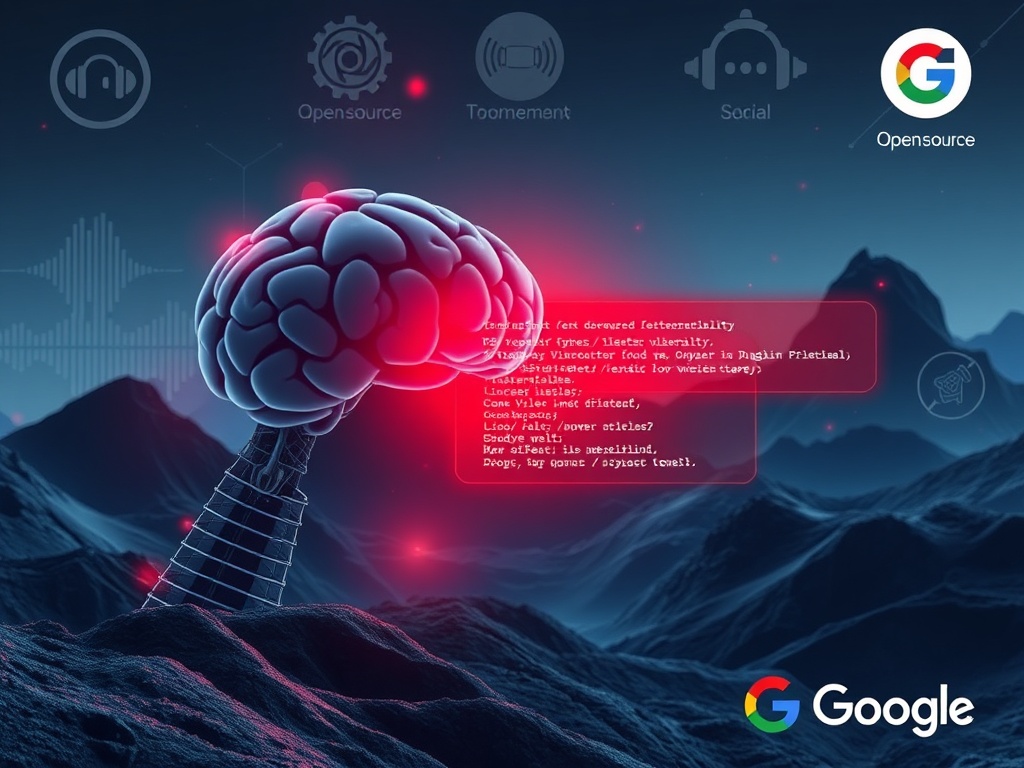BitcoinWorld

AI Bug Hunter Revolutionizes Cybersecurity: Google’s Big Sleep Uncovers 20 Critical Flaws
The digital landscape, much like the dynamic world of cryptocurrencies, operates on the bedrock of trust and security. As artificial intelligence rapidly evolves, a formidable new guardian is emerging to fortify our digital defenses: the AI bug hunter. Google’s recent announcement regarding its cutting-edge AI, “Big Sleep,” marks a pivotal moment, showcasing AI’s profound capability to pinpoint critical software flaws before malicious actors can exploit them. This development is not just a technological feat; it’s a significant step towards a more resilient digital future for everyone, from individual users to large-scale enterprises relying on complex software ecosystems.
AI Bug Hunter: Google’s Big Sleep Uncovers 20 Critical Flaws
Google’s AI-powered vulnerability researcher, aptly named “Big Sleep” – a nod to its deep learning capabilities – has officially reported its inaugural batch of 20 security vulnerabilities. This groundbreaking achievement was announced by Heather Adkins, Google’s Vice President of Security, highlighting the practical application of advanced AI in safeguarding digital infrastructure. Developed through a powerful collaboration between Google’s AI division, DeepMind, and its elite hacking team, Project Zero, Big Sleep meticulously identified these flaws primarily within popular open-source software. Specifically, the audio and video processing library FFmpeg and the image-editing suite ImageMagick were among the affected projects. These applications are foundational components for countless digital services and products, meaning a vulnerability in them could have far-reaching consequences across various industries, including those interacting with blockchain and digital assets.
The fact that Big Sleep autonomously found and reproduced these vulnerabilities is profoundly significant. While Google maintains a standard policy of withholding specific details until the bugs are fixed – a responsible approach to prevent exploitation – the very existence of these findings underscores the immense potential of AI in cybersecurity. Royal Hansen, Google’s Vice President of Engineering, aptly described these discoveries as demonstrating “a new frontier in automated vulnerability discovery.” This isn’t just about speed; it’s about the ability of AI to sift through vast amounts of code, identify intricate patterns, and predict potential weaknesses with a precision and scale that often eludes human analysis alone. The implications for the rapid detection and mitigation of threats are immense, offering a proactive shield against evolving cyber dangers.
Google AI and the Human Element in Cybersecurity
The success of Big Sleep is a testament to the sophisticated capabilities of Google AI, particularly in the realm of large language models (LLMs) applied to security research. DeepMind brings its unparalleled expertise in AI development, while Project Zero contributes its world-renowned experience in identifying zero-day vulnerabilities and advanced persistent threats. This synergy is crucial for training an AI that can truly understand the nuances of code and potential exploits. However, the path to a fully autonomous AI bug hunter is still evolving. Google’s spokesperson, Kimberly Samra, clarified that “To ensure high quality and actionable reports, we have a human expert in the loop before reporting, but each vulnerability was found and reproduced by the AI agent without human intervention.”
This “human-in-the-loop” approach is a critical distinction. It means that while the AI performs the arduous task of initial discovery and reproduction, human intelligence provides the final layer of verification and strategic judgment. This collaboration is vital for several reasons: it ensures the validity of the findings, prioritizes vulnerabilities based on real-world impact, and helps to refine the AI’s learning process by filtering out false positives. Far from being a limitation, this partnership signifies the most effective way to leverage AI in complex domains like cybersecurity, where precision and context are paramount. It illustrates a future where AI augments human capabilities, rather than entirely replacing them, leading to a more robust and intelligent defense system against digital threats.
The Expanding Cybersecurity AI Landscape: Beyond Big Sleep
Google’s Big Sleep is a prominent example, but it operates within a rapidly expanding ecosystem of cybersecurity AI tools. The concept of LLM-powered systems designed to identify and exploit vulnerabilities is no longer theoretical; it’s a tangible reality. Beyond Big Sleep, other notable players include RunSybil and XBOW. Each of these tools brings a unique approach to the challenge of automated vulnerability discovery. XBOW, for instance, has already garnered significant attention, reaching the top of one of the U.S. leaderboards on HackerOne, a leading bug bounty platform. This achievement underscores the practical efficacy of such AI tools in a competitive, real-world environment where the stakes are high and accuracy is rewarded.
The emergence of these diverse AI solutions signifies a “new frontier” not just in discovery but in the entire cybersecurity paradigm. They promise to dramatically increase the speed and scale at which vulnerabilities can be found, potentially shifting the advantage from attackers to defenders. Vlad Ionescu, co-founder and CTO of RunSybil, offered a professional endorsement of Big Sleep, stating that it is a “legit” project due to its “good design, people behind it know what they’re doing, Project Zero has the bug finding experience and DeepMind has the firepower and tokens to throw at it.” This expert validation from within the industry highlights the credibility and robust foundation of Google’s initiative. The increasing investment and innovation in this sector indicate a collective recognition of AI’s potential to revolutionize digital defense, making the internet a safer place for all forms of digital interaction, including the burgeoning Web3 space.
Navigating the Challenges of Security Vulnerabilities: The “AI Slop” Dilemma
While the promise of AI-driven vulnerability discovery is immense, it’s not without its significant hurdles. One of the most pressing concerns within the cybersecurity community, particularly among those who maintain various software projects, is the phenomenon of “hallucinations.” These are instances where AI-powered bug hunters generate reports that, despite appearing legitimate, are actually erroneous or non-existent vulnerabilities. This issue has led some to label these misleading reports as the “bug bounty equivalent of AI slop,” a term that vividly captures the frustration experienced by developers who must sift through potentially useless data.
Vlad Ionescu of RunSybil previously articulated this challenge, stating, “That’s the problem people are running into, is we’re getting a lot of stuff that looks like gold, but it’s actually just crap.” This “AI slop” can significantly burden development teams, consuming valuable time and resources as they investigate false alarms. It highlights a critical area for improvement in AI models: enhancing their ability to discern true vulnerabilities from patterns that merely resemble them. Addressing this requires more sophisticated training datasets, better contextual understanding by the AI, and robust feedback mechanisms from human experts. The goal is to maximize the efficiency of AI in identifying security vulnerabilities while minimizing the overhead associated with false positives, ensuring that these powerful tools remain a net positive for the cybersecurity community rather than adding to its workload.
Strengthening Open-Source Security with AI Innovation
The primary targets of Big Sleep’s initial findings were prominent open-source projects like FFmpeg and ImageMagick. This focus underscores the profound and transformative implications of AI for open-source security. Open-source software forms the backbone of vast swathes of the internet and modern technology, from operating systems to web servers, and increasingly, components of blockchain infrastructure. Its collaborative nature, while fostering innovation, can also present unique security challenges, as vulnerabilities might remain undetected for longer periods due to the sheer volume of code and diverse developer contributions.
Traditionally, open-source security relies heavily on community vigilance, manual code reviews, and bug bounty programs. While effective, these methods can be time-consuming and may not scale adequately with the exponential growth of open-source projects. AI-powered tools like Big Sleep offer a game-changing solution. They can rapidly scan and analyze millions of lines of code, identifying subtle flaws that might be missed by human eyes or traditional automated scanners. This capability allows for a more proactive approach to security, potentially reducing the window of opportunity for attackers. By enhancing the integrity and resilience of open-source software, AI contributes to the overall stability and trustworthiness of the digital ecosystem, directly benefiting industries built upon these foundational technologies, including the cryptocurrency space which frequently leverages open-source code for its protocols and applications. The continuous refinement of these AI tools promises to make open-source software even more secure and reliable for global adoption.
Conclusion: AI’s Pivotal Role in a Secure Digital Future
Google’s Big Sleep represents a momentous leap forward in the application of AI to cybersecurity. By successfully identifying 20 critical vulnerabilities in widely used open-source software, it unequivocally demonstrates the immense potential of AI as a powerful ally in the ongoing battle against cyber threats. This achievement ushers in an era of more proactive, efficient, and scalable digital defense mechanisms. While the integration of human expertise remains vital for validating AI-generated reports and mitigating the challenge of “AI slop,” the trajectory is clear: AI is poised to become an indispensable component of our cybersecurity infrastructure.
The collaboration between advanced AI capabilities and human oversight promises a future where digital systems are inherently more resilient. As AI models become more sophisticated and their ability to discern genuine threats from false positives improves, we can anticipate a significant reduction in the time it takes to identify and patch vulnerabilities. This not only safeguards sensitive data and critical infrastructure but also fosters greater trust in the digital economy, including the burgeoning cryptocurrency and blockchain sectors. The continuous evolution of AI in cybersecurity will undoubtedly shape a more secure and reliable digital landscape for generations to come, transforming how we protect our digital assets and interactions.
To learn more about the latest AI trends, explore our article on key developments shaping AI models and institutional adoption.
This post AI Bug Hunter Revolutionizes Cybersecurity: Google’s Big Sleep Uncovers 20 Critical Flaws first appeared on BitcoinWorld and is written by Editorial Team





